
Malachite is a copper carbonate hydroxide mineral, with the formula Cu2CO3(OH)2. This opaque, green-banded mineral crystallizes in the monoclinic crystal system, and most often forms botryoidal, fibrous, or stalagmitic masses, in fractures and deep, underground spaces, where the water table and hydrothermal fluids provide the means for chemical precipitation. Individual crystals are rare, but occur as slender to acicular prisms. Pseudomorphs after more tabular or blocky azurite crystals also occur.

Serpentine subgroup are greenish, brownish, or spotted minerals commonly found in serpentinite. They are used as a source of magnesium and asbestos, and as decorative stone. The name comes from the greenish colour and smooth or scaly appearance from the Latin serpentinus, meaning "serpent rock".
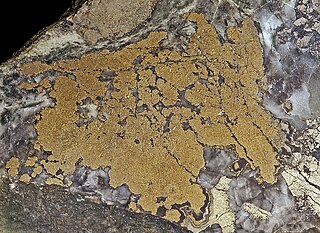
Nickeline or niccolite is a mineral consisting primarily of nickel arsenide (NiAs). The naturally-occurring mineral contains roughly 43.9% nickel and 56.1% arsenic by mass, but composition of the mineral may vary slightly.

Garnierite is a general name for a green nickel ore which is found in pockets and veins within weathered and serpentinized ultramafic rocks. It forms by lateritic weathering of ultramafic rocks and occurs in many nickel laterite deposits in the world. It is an important nickel ore, having a large weight percent NiO. As garnierite is not a valid mineral name according to the Commission on New Minerals, Nomenclature and Classification (CNMNC), no definite composition or formula has been universally adopted. Some of the proposed compositions are all hydrous Ni-Mg silicates, a general name for the Ni-Mg hydrosilicates which usually occur as an intimate mixture and commonly includes two or more of the following minerals: serpentine, talc, sepiolite, smectite, or chlorite, and Ni-Mg silicates, with or without alumina, that have x-ray diffraction patterns typical of serpentine, talc, sepiolite, chlorite, vermiculite or some mixture of them all.

Erythrite or red cobalt is a secondary hydrated cobalt arsenate mineral with the formula Co
3(AsO
4)
2•8H
2O. Erythrite and annabergite, chemical formula Ni
3(AsO
4)
2•8H
2O, or nickel arsenate form a complete series with the general formula (Co,Ni)
3(AsO
4)
2•8H
2O.

Zaratite is a bright emerald green nickel carbonate mineral with formula Ni3CO3(OH)4·4H2O. Zaratite crystallizes in the isometric crystal system as massive to mammillary encrustations and vein fillings. It has a specific gravity of 2.6 and a Mohs hardness of 3 to 3.5. It has no cleavage and is brittle to conchoidal fracture. The luster is vitreous to greasy.

Hellyerite, NiCO3·6(H2O), is an hydrated nickel carbonate mineral. It is light blue to bright green in colour, has a hardness of 2.5, a vitreous luster, a white streak and crystallises in the monoclinic system. The crystal habit is as platy and mammillary encrustations on its matrix.
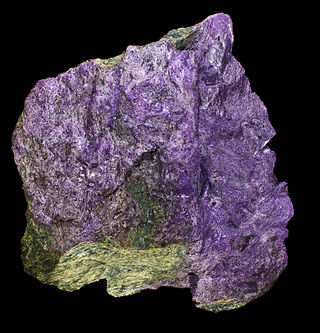
Stichtite is a mineral, a carbonate of chromium and magnesium; formula Mg6Cr2CO3(OH)16·4H2O. Its colour ranges from pink through lilac to a rich purple colour. It is formed as an alteration product of chromite containing serpentine. It occurs in association with barbertonite (the hexagonal polymorph of Mg6Cr2CO3(OH)16·4H2O), chromite and antigorite.

Heazlewoodite, Ni3S2, is a rare sulfur-poor nickel sulfide mineral found in serpentinitized dunite. It occurs as disseminations and masses of opaque, metallic light bronze to brassy yellow grains which crystallize in the trigonal crystal system. It has a hardness of 4, a specific gravity of 5.82. Heazlewoodite was first described in 1896 from Heazlewood, Tasmania, Australia.
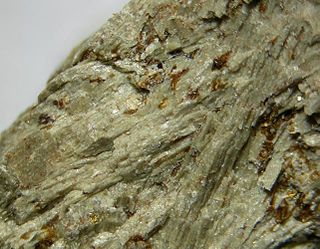
Aliettite is a complex phyllosilicate mineral of the smectite group with a formula of (Ca0.2Mg6(Si,Al)8O20(OH)4·4H2O) or [Mg3Si4O10(OH)2](Ca0.5,Na)0.33(Al,Mg,Fe2+)2−3(Si,Al)4O10(OH)2·n(H2O).

Népouite is a rare nickel silicate mineral which has the apple green color typical of such compounds. It was named by the French mining engineer Edouard Glasser in 1907 after the place where it was first described, the Népoui Mine, Népoui, Poya Commune, North Province, New Caledonia. The ideal formula is Ni3(Si2O5)(OH)4, but most specimens contain some magnesium, and (Ni,Mg)3(Si2O5)(OH)4 is more realistic. There is a similar mineral called lizardite in which all of the nickel is replaced by magnesium, formula Mg3(Si2O5)(OH)4. These two minerals form a series; intermediate compositions are possible, with varying proportions of nickel to magnesium.
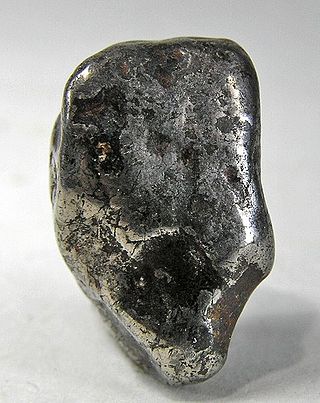
Awaruite is a naturally occurring alloy of nickel and iron with a composition from Ni2Fe to Ni3Fe.
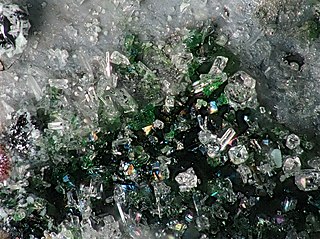
Bunsenite is the naturally occurring form of nickel(II) oxide, NiO. It occurs as rare dark green crystal coatings. It crystallizes in the cubic crystal system and occurs as well formed cubic, octahedral and dodecahedral crystals. It is a member of the periclase group.

Millerite is a nickel sulfide mineral, NiS. It is brassy in colour and has an acicular habit, often forming radiating masses and furry aggregates. It can be distinguished from pentlandite by crystal habit, its duller colour, and general lack of association with pyrite or pyrrhotite.
Manganoblödite is a rare manganese mineral with the formula Na2Mn(SO4)2·4H2O. Somewhat chemically similar mineral is D'Ansite-(Mn). Manganoblödite was found in the Blue Lizard mine, San Juan County, Utah, US, which is known for several relatively new secondary uranium minerals In the mine, manganoblödite occurs intimately intergrown with manganese-, cobalt- and nickel-enriched blödite and a yet another new mineral - cobaltoblödite. Manganoblödite, as suggested by its name is a manganese-analogue of blödite. It is also analogous to changoite, cobaltoblödite and nickelblödite - all three are members of the blödite group.
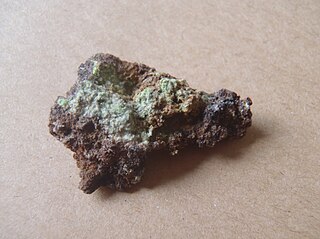
Nickelblödite is a rare nickel sulfate mineral with the formula Na2Ni(SO4)2·4H2O. Nickelblödite was discovered in nickel mines in Carr Boyd Rocks and Kambalda, Western Australia. The mineral is a nickel-analogue of blödite, changoite, cobaltoblödite and manganoblödite - other representatives of the blödite group.
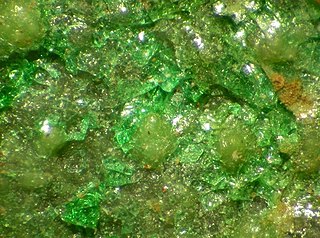
Widgiemoolthalite is a rare hydrated nickel(II) carbonate mineral with the chemical formula (Ni,Mg)5(CO3)4(OH)2·5H2O. Usually bluish-green in color, it is a brittle mineral formed during the weathering of nickel sulfide. Present on gaspéite surfaces, widgiemoolthalite has a Mohs scale hardness of 3.5 and an unknown though likely disordered crystal structure. Widgiemoolthalite was first discovered in 1992 in Widgiemooltha, Western Australia, which is to date its only known source. It was named the following year by the three researchers who first reported its existence, Ernest H. Nickel, Bruce W. Robinson, and William G. Mumme.

Antigorite is a lamellated, monoclinic mineral in the phyllosilicate serpentine subgroup with the ideal chemical formula of (Mg,Fe2+)3Si2O5(OH)4. It is the high-pressure polymorph of serpentine and is commonly found in metamorphosed serpentinites. Antigorite, and its serpentine polymorphs, play an important role in subduction zone dynamics due to their relative weakness and high weight percent of water (up to 13 weight % H2O). It is named after its type locality, the Geisspfad serpentinite, Valle Antigorio in the border region of Italy/Switzerland and is commonly used as a gemstone in jewelry and carvings.

Lizardite is a mineral from the serpentine subgroup with formula Mg3(Si2O5)(OH)4, and the most common type of mineral in the subgroup. It is also a member of the kaolinite-serpentine group.
Falcondoite, a member of the sepiolite group, was first discovered in the Dominican Republic, near the town of Bonao. The mineral was found in a deposit mined by Falconbridge Dominica, and so was named "falcondoite" after the company. Falcondoite is frequently associated with sepiolite, garnierite, talc, and serpentine, and is commonly nickel-bearing. While the chemical formula for falcondoite can vary, the mineral must contain more nickel than magnesium to be considered its own species. The ideal chemical formula for falcondoite is (Ni,Mg)4Si6O15(OH)2·6H2O.


















